8 mol% Y2O3-stabilized zirconia (8YSZ) transparent ceramics with high optical and mechanical performance through YF3 sintering additive
IF 5.8
2区 材料科学
Q1 MATERIALS SCIENCE, CERAMICS
Journal of The European Ceramic Society
Pub Date : 2025-06-13
DOI:10.1016/j.jeurceramsoc.2025.117621
引用次数: 0
Abstract
In this study, YF3 was utilized as a novel sintering additive in fabricating high-performance 8YSZ transparent ceramics. A series of undoped and YF3-doped 8YSZ transparent ceramics were fabricated through air pre-sintering combined with hot isostatic pressing (HIP). The influence of the YF3 content on the sintering behavior, microstructure, and optical properties of the 8YSZ transparent ceramics was systematically investigated. In detail, the addition of YF3 (0.02–0.2 wt%) significantly enhanced densification, while exerting negligible effects on grain growth. Notably, excessive YF3 (>0.1 wt%) induced volatile gas evolution, resulting in residual porosity and reduced densification efficiency. By employing optimized processing conditions (0.1 wt% YF3 additive and HIP at 1550 °C), the as-prepared 8YSZ transparent ceramic exhibited superior optical and mechanical performance. The optimal properties included 71.4 % in-line transmittance at 600 nm (∼94 % of the theoretical limit), Vickers hardness of 12.4 ± 0.3 GPa, and flexural strength of 329 ± 38 MPa. These results highlight the beneficial effect and criticality of content control for YF3 additives in achieving high-quality transparent 8YSZ ceramics.
通过YF3烧结添加剂制备的具有高光学性能和机械性能的y2o3稳定氧化锆(8YSZ)透明陶瓷
本研究将YF3作为新型烧结添加剂用于制备高性能的8YSZ透明陶瓷。采用空气预烧结和热等静压相结合的方法制备了一系列未掺杂和掺杂yf3的8YSZ透明陶瓷。系统研究了YF3含量对8YSZ透明陶瓷烧结性能、显微结构和光学性能的影响。其中,YF3(0.02 ~ 0.2 wt%)的添加显著增强了致密化,对晶粒生长的影响可以忽略不计。值得注意的是,过量的YF3 (>0.1 wt%)诱导挥发性气体析出,导致残余孔隙度和致密化效率降低。通过优化的工艺条件(0.1 wt% YF3添加剂和1550℃的HIP),制备的8YSZ透明陶瓷具有优异的光学和机械性能。最优属性包括71.4 %内联透光率在600 海里(94∼ %的理论极限),维氏硬度的12.4 ±0.3 GPa,和挠曲强度329 ± 38 MPa。这些结果突出了YF3添加剂含量控制对获得高质量透明8YSZ陶瓷的有益作用和重要性。
本文章由计算机程序翻译,如有差异,请以英文原文为准。
求助全文
约1分钟内获得全文
求助全文
来源期刊

Journal of The European Ceramic Society
工程技术-材料科学:硅酸盐
CiteScore
10.70
自引率
12.30%
发文量
863
审稿时长
35 days
期刊介绍:
The Journal of the European Ceramic Society publishes the results of original research and reviews relating to ceramic materials. Papers of either an experimental or theoretical character will be welcomed on a fully international basis. The emphasis is on novel generic science concerning the relationships between processing, microstructure and properties of polycrystalline ceramics consolidated at high temperature. Papers may relate to any of the conventional categories of ceramic: structural, functional, traditional or composite. The central objective is to sustain a high standard of research quality by means of appropriate reviewing procedures.
 求助内容:
求助内容: 应助结果提醒方式:
应助结果提醒方式:


